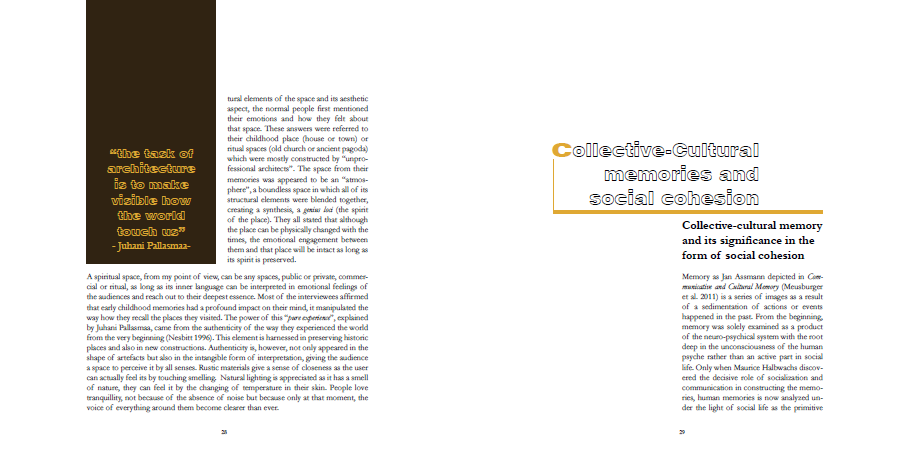[S01.4] Non-religious Spiritual space for social cohesion in Vietnam

bstract
Chapter 1: Land and People
Chapter 2: Non- religious spiritual space within the framework of social concerns
Chapter 3: Collective- cultural memory and social cohesion
Chapter 4: Case studies
Chapter 5: Design Solution
Chapter 3. Collective- cultural memory and social cohesion
3.1 Collective- cultural memory and its significance in the social cohesion
Memory as Jan Assmann depicted in Communicative and Cultural Memory (Meusburger et al. 2011) is a series of images as a result of sedimentation of actions or events that happened in the past. From the beginning, memory was merely examined as a product of the neuro-psychical system with the root deep in the unconsciousness of the human psyche rather than an active part in social life. Only when Maurice Halbwachs discovered the decisive role of socialization and communication in constructing the memories, human memories is now analyzed under the light of social life as the primitive social bond. That is to say, human memory functions as a connective structure for developing a narrative of identity personally and collectively.
Collective memory from the definition of Maurice Halbwachs or Jan Assmann is representations of the past that are memorized by a community. Meanwhile, cultural memory is a form of collective memory in that a group of people share the same values in the realm of tradition and culture, described by Sturken, cited in “Cultural Memories”, as:
“memory that is shared outside the avenues of formal historical discourse yet is entangled with cultural products and imbued with the cultural meaning” (Meusburger et al. 2011)
Christina West took a step further in schematizing the mnemonic process into three dimensions of memory in her research Memory- Recollection- Culture- Identity- Space: Social context, Identity Formation, and Self-construction of the Cale in Spain (Meusburger et al. 2011). As can be seen in figure 01, at the individual level, communicative memories are constructed bottom-up from personal memories of daily life and everyday interaction before being generalized into a collective possession. Therefore, these memories are generational, transient and volatile. In the meantime, these collective recollections when are embedded in the cultural sphere and then exist as archived artefacts such as narratives, songs, poems, symbols, etc, they eventually become cultural memories. By this mean, cultural memories are institutional, persistent and consolidating.

